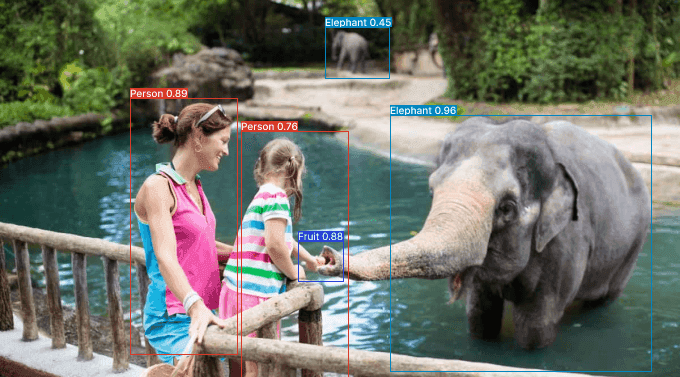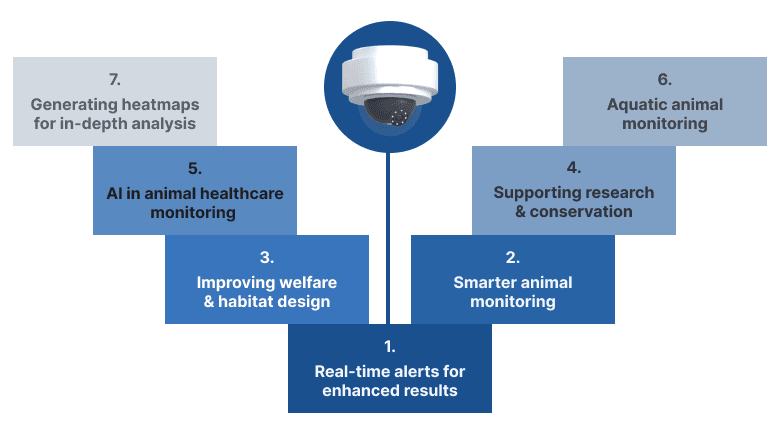The Journey from Surveillance to Compassion: Importance of Computer vision in Zoo & Animal Welfare

Zoo environments are evolving not only in design but also in educating visitors. A quiet tech revolution, nowadays, is often empowered by computer vision. The AI-powered technology is offering zookeepers smarter tools for monitoring and taking care of animals. With the wildlife spaces hosting a wide range of species, each animal comes with unique needs. Using advanced technology zookeepers and animal caretakers are trying to improve the way animals are observed and supported. Vision AI models such as Ultralytics YOLO11 and footfall counting for zoos allow machines to view and interpret images. It can be used to detect individual animals, monitor their movements and detect early signs of illness. In this blog, we are going to explore the way computer vision is used in zoos for monitoring health and tracking behavior.
Importance of computer vision in zoos and wildlife care
The 21st century is marking major developments in the tech industry. Computer vision powered by AI is emerging as a transformative tool for both zoos and the wild.

Real-time alerts for enhanced results
AI algorithms are capable of identifying suspicious movement patterns such as reduced activity, limping and health issues in real-time. On identification, it sends immediate alerts to caretakers enabling proactive intervention thereby preventing issues from escalating into serious medical care.
Smarter animal monitoring
The implications of Visionfacts AI are imperative and wider for zoos. Integrating advanced intelligence along with computer vision allows for continuous and non-intrusive observation of animal behavior. From tracking movement, sleep patterns, eating habits and social interactions to understanding their needs in real-time, it generates effective insights of their health and behavior.
Improving welfare & habitat design
Zoos and wildlife sanctuaries can remodel the enclosures leveraging visual data gathered from AI surveillance cameras. The spaces can be redesigned to match an animal's natural movement and behavior.
Supporting research & conservation
Are you aware of the advanced People counting system for Zoo? Well, in the wild, AI-powered counting systems help to identify and track animals using pattern recognition. It simplifies population tracking, poaching prevention, and the development of conservation strategies.
AI in animal healthcare monitoring
There are certain animals that are solitary, confronting challenges to survival. In several parts of the world, certain animals have become extinct over the course of time. Even at protected places such as zoos, health issues hit the wildlife town. Traditional forms of manual monitoring come with a plethora of challenges. However with advanced intelligence, animals can be monitored in real time displaying signs of limping and less activity. Several object detection models such as YOLOv8 can be designed for monitoring animal behavior.
Aquatic animal monitoring: A close watch on dolphins
Analyzing animal behavior in water manually can be a tedious task. It is challenging and often involves errors. Leveraging object tracking and computer vision, movement of aquatic animals can be seamlessly monitored. The AI surveillance cameras capture visual data and tracking their patterns aquatic animal caregivers can acquire insights into the various ways dolphins and other animals interact.
Generating heatmaps for in-depth analysis
With Visionfacts AI, the data can be transferred into informative heatmaps. The heatmaps display the duration of time the animals spend in distinct areas. It provides insights into their preferred locations and behavioral patterns over a certain period of time.
Why choosing Visionfacts AI is ideal for animal welfare facility
Within a zoo enclosure, multiple caretakers are deployed to monitor and help animals. However, manual monitoring isn't always enough to protect species at different spaces of the zoo facility.

Conservation & wildlife tracking
Computer vision powered by AI helps in tracking endangered species and detecting individuals through monitoring movement patterns and pattern recognition. It is vital for research and ecosystem protection.
Real-time monitoring
It promotes continuous monitoring of animals providing a comprehensive understanding of behavior throughout the day & night. The real-time data enables prompt interventions in case of unusual behavior detection.
Early detection of health issues
AI algorithms analyze behavior patterns where computer vision can detect signs of illness prior to them becoming critical. It enables zookeeper and wildlife professionals to intervene quickly advancing health outcomes.
Step towards data-driven animal care
Vision AI enables caretakers to have a firm grasp of real-time data and actionable insights leading the way for efficient and individualized animal care.
Improved night-time monitoring
The Vision AI monitoring systems enable staff to monitor animals even at night time. The night time monitoring system enables zookeepers to keep a close watch on rare animals without error.
Final thought
By harnessing advanced machine learning algorithms, zoo facilities and animal welfare spaces can boost their continuous monitoring of health, animal monitoring and habitat conditions. Computer vision powered by Artificial Intelligence is rapidly transforming zoo management. Beginning from improving enrichment & welfare to early detection of diseases, the vision AI technology empowers caretakers with real time insights resulting in smarter and comfy animal welfare space.
Do you want to upgrade your zoo facility infrastructure? You don't have to think further. As one of the leading AI video analytics companies, Visionfacts AI focuses on creating tailor-made solutions for different industries and businesses.
Reach out to our professionals to know more about AI video analytics.
Frequently asked questions
What types of data can be captured through computer vision?
Computer vision can easily gather information depending on behaviour, movement patterns, sleep cycles, enclosure usage, and signs of discomfort.
What is computer vision & how does it apply to zoos?
Computer vision is considered a set of AI that allows machines to interpret and analyse visual information. Across a zoo facility, it assists in monitoring animal behaviour, identifying anomalies and tracking movements for improving care and management.
Is computer vision technology invasive to animals?
Not at all, AI video analytics software technology leverages non-invasive cameras as well as sensors for monitoring distant objects. Meanwhile, it ensures minimal disturbance to the animal’s natural behaviour.
How does computer vision assist in understanding animal’s life patterns?
In terms of analyzing long-term data, AI can disclose trends in group behaviour, recognize stressors, and predict events. The predictive analytics help in detecting early signs of health risks and mating cycles.
What do you consider the challenges in implementing computer vision in zoos?
Different ranges of challenges involve high setup costs, varied conditions, reliable data infrastructure, and the requirements of species-specific models.
How does the Vision AI technology contribute to research and conservation efforts?
In terms of gathering precise behavioural data over time, research professionals can acquire advanced insights into animal habits. The technology is valuable for any kind of breeding program, species conservation, and habitat enrichment techniques.